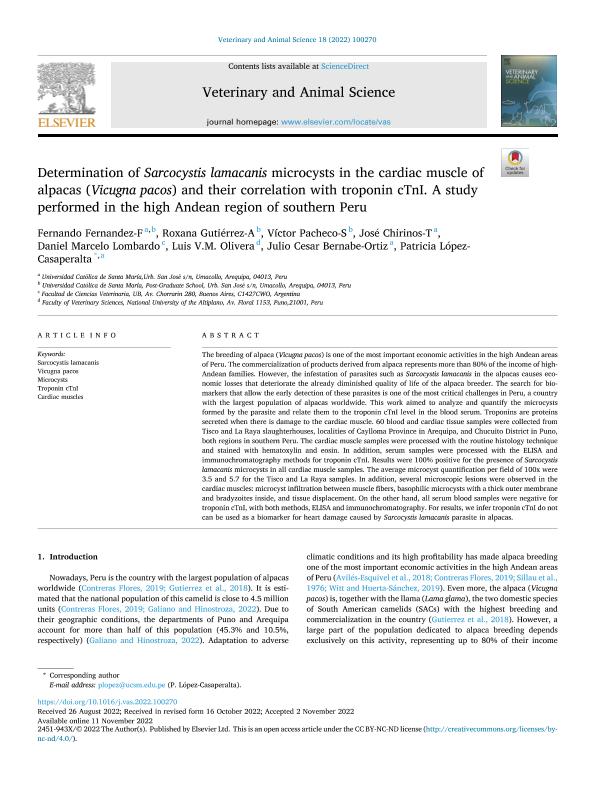Mostrar el registro sencillo del ítem
dc.contributor.author
Fernandez F., Fernando
dc.contributor.author
Gutiérrez A., Roxana
dc.contributor.author
Pacheco S., Víctor
dc.contributor.author
Chirinos T., José
dc.contributor.author
Lombardo, Daniel Marcelo

dc.contributor.author
Olivera, Luis V. M.
dc.contributor.author
Bernabe Ortiz, Julio Cesar
dc.contributor.author
López Casaperalta, Patricia
dc.date.available
2024-01-19T13:29:50Z
dc.date.issued
2022-12
dc.identifier.citation
Fernandez F., Fernando; Gutiérrez A., Roxana; Pacheco S., Víctor; Chirinos T., José; Lombardo, Daniel Marcelo; et al.; Determination of Sarcocystis lamacanis microcysts in the cardiac muscle of alpacas (Vicugna pacos) and their correlation with troponin cTnI. A study performed in the high Andean region of southern Peru; Elsevier; Veterinary and Animal Science; 18; 12-2022; 1-7
dc.identifier.uri
http://hdl.handle.net/11336/224267
dc.description.abstract
The breeding of alpaca (Vicugna pacos) is one of the most important economic activities in the high Andean areas of Peru. The commercialization of products derived from alpaca represents more than 80% of the income of high-Andean families. However, the infestation of parasites such as Sarcocystis lamacanis in the alpacas causes economic losses that deteriorate the already diminished quality of life of the alpaca breeder. The search for biomarkers that allow the early detection of these parasites is one of the most critical challenges in Peru, a country with the largest population of alpacas worldwide. This work aimed to analyze and quantify the microcysts formed by the parasite and relate them to the troponin cTnI level in the blood serum. Troponins are proteins secreted when there is damage to the cardiac muscle. 60 blood and cardiac tissue samples were collected from Tisco and La Raya slaughterhouses, localities of Caylloma Province in Arequipa, and Chucuito District in Puno, both regions in southern Peru. The cardiac muscle samples were processed with the routine histology technique and stained with hematoxylin and eosin. In addition, serum samples were processed with the ELISA and immunochromatography methods for troponin cTnI. Results were 100% positive for the presence of Sarcocystis lamacanis microcysts in all cardiac muscle samples. The average microcyst quantification per field of 100x were 3.5 and 5.7 for the Tisco and La Raya samples. In addition, several microscopic lesions were observed in the cardiac muscles: microcyst infiltration between muscle fibers, basophilic microcysts with a thick outer membrane and bradyzoites inside, and tissue displacement. On the other hand, all serum blood samples were negative for troponin cTnI, with both methods, ELISA and immunochromatography. For results, we infer troponin cTnI do not can be used as a biomarker for heart damage caused by Sarcocystis lamacanis parasite in alpacas.
dc.format
application/pdf
dc.language.iso
eng
dc.publisher
Elsevier

dc.rights
info:eu-repo/semantics/openAccess
dc.rights.uri
https://creativecommons.org/licenses/by-nc-nd/2.5/ar/
dc.subject
CARDIAC MUSCLES
dc.subject
MICROCYSTS
dc.subject
SARCOCYSTIS LAMACANIS
dc.subject
TROPONIN CTNI
dc.subject
VICUGNA PACOS
dc.subject.classification
Otras Ciencias Veterinarias

dc.subject.classification
Ciencias Veterinarias

dc.subject.classification
CIENCIAS AGRÍCOLAS

dc.title
Determination of Sarcocystis lamacanis microcysts in the cardiac muscle of alpacas (Vicugna pacos) and their correlation with troponin cTnI. A study performed in the high Andean region of southern Peru
dc.type
info:eu-repo/semantics/article
dc.type
info:ar-repo/semantics/artículo
dc.type
info:eu-repo/semantics/publishedVersion
dc.date.updated
2024-01-18T14:09:46Z
dc.identifier.eissn
2451-943X
dc.journal.volume
18
dc.journal.pagination
1-7
dc.journal.pais
Países Bajos

dc.journal.ciudad
Amsterdam
dc.description.fil
Fil: Fernandez F., Fernando. Universidad Católica de Santa María; Perú
dc.description.fil
Fil: Gutiérrez A., Roxana. Universidad Católica de Santa María; Perú
dc.description.fil
Fil: Pacheco S., Víctor. Universidad Católica de Santa María; Perú
dc.description.fil
Fil: Chirinos T., José. Universidad Católica de Santa María; Perú
dc.description.fil
Fil: Lombardo, Daniel Marcelo. Consejo Nacional de Investigaciones Científicas y Técnicas. Oficina de Coordinación Administrativa Parque Centenario; Argentina. Universidad de Buenos Aires. Facultad de Ciencias Veterinarias. Instituto de Investigacion y Tecnología en Reproducción Animal; Argentina. Universidad de Buenos Aires. Facultad de Ciencias Veterinarias. Cátedra de Histología y Embriologías; Argentina
dc.description.fil
Fil: Olivera, Luis V. M.. Universidad Nacional del Altiplano; Perú
dc.description.fil
Fil: Bernabe Ortiz, Julio Cesar. Universidad Católica de Santa María; Perú
dc.description.fil
Fil: López Casaperalta, Patricia. Universidad Católica de Santa María; Perú
dc.journal.title
Veterinary and Animal Science
dc.relation.alternativeid
info:eu-repo/semantics/altIdentifier/url/https://www.sciencedirect.com/science/article/pii/S2451943X22000412
dc.relation.alternativeid
info:eu-repo/semantics/altIdentifier/doi/http://dx.doi.org/10.1016/j.vas.2022.100270
Archivos asociados
